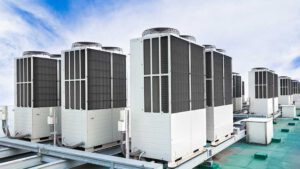Whether you own, operate, or manage a commercial building, your HVAC system is important. You need to make sure it stays in good condition for you and your staff.
The equipment is a lot more complex than residential systems, which calls for specialized tools and technicians with specific expertise. Regular maintenance is also needed to ensure a commercial HVAC system lasts for years to come. For professional help, contact Lexington Heating And Air.
A split system air conditioner is a type of central air conditioning unit that has its primary components separated and housed in two different areas. The outdoor component, often called the condenser, is located outside the building, and the indoor part of the air conditioner is housed inside. The refrigerant flows between the two through copper tubes, cooling and heating the indoor air.
In a traditional home, the outdoor unit is usually located in the backyard or on the side of the house, while the indoor unit can be found in a utility room or in an attic space. In commercial buildings, however, the outdoor unit is usually on the roof of the building, and the indoor unit is located in a utility room or another room.
These systems are a good choice for large commercial spaces such as office buildings, hotels, and schools because they have high-efficiency ratings and offer many options to control the temperature and comfort level of the building. They also come with factory-installed microprocessor controls for connected functionality, real-time diagnostics, and remote monitoring.
The evaporator coil and compressor in a split system are separate from the outdoor unit, making it easier to install. They also have fewer parts, which makes them easier to service.
In addition to evaporators and compressors, a split system contains an indoor fan, which circulates the indoor air. Some have a built-in humidifier to provide moisture to the air, which can help reduce energy use and improve air quality.
They are a great option for small businesses, as they can be used to heat and cool individual rooms, such as a shop or server room. They can also be used in combination to serve larger areas or multiple rooms, and they are inexpensive to buy and install.
Most mini-split systems have a single outdoor unit that connects to up to four indoor air-handling units (evaporators). They are easy to install and require only a three-inch hole in a wall for a conduit that houses the power cables, refrigerant tubing, suction tubing, and a condensation drain line connecting the outdoor and indoor units.
Ductless commercial HVAC systems are an alternative to traditional HVAC equipment. They are more efficient, easier to install, and use less power than a central air conditioner or heat pump system, which means they can cut energy costs by up to 30%.
A ductless system is comprised of one outdoor unit, which typically pumps air into a series of refrigerant lines that connect to indoor units in different rooms. The units can be mounted on the wall, in a ceiling-recessed cassette, or suspended above a floor.
Besides being more energy efficient, ductless systems also offer improved cooling control unlike central air, which uses mechanical opening and closing of vents to control the temperature of zones, a ductless AC system can be programmed for individual room temperatures, enabling greater precision.
Another advantage of ductless mini-split systems is their ease of installation and maintenance. The connection between the indoor and outdoor units generally requires only a small hole through a wall, allowing for quick installation with minimum disruption to business operations.
In addition, a ductless system can save you money in the long run by eliminating the need to add ducts or other specialized plumbing to your building. Moreover, many of these systems are ENERGY STAR-rated, which exceeds the efficiency standards for heating and cooling.
